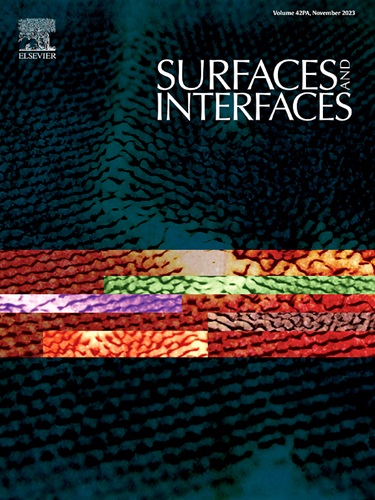利用密度泛函理论探索AlFe3N和gfe3n作为化学环氨合成的氮载体
IF 6.3
2区 材料科学
Q2 CHEMISTRY, PHYSICAL
引用次数: 0
摘要
对可持续氨生产的迫切需求促使人们探索替代能源密集型哈伯-博世工艺。本研究采用密度泛函理论(DFT)计算评价了铁基反钙钛矿氮化物AlFe3N和GaFe3N在化学环合成绿色氨中的催化性能。稳定性分析,包括声子色散、AIMD模拟和弹性常数,证实了这两种材料的动态、热和机械鲁棒性。电子结构结果显示出金属和铁磁行为,由于Ga的电负性较高,gfe3n中的Fe-N键较弱,从而增强了电荷转移和表面反应性。热力学计算表明,AlFe3N和GaFe3N的氢化和氮化反应在低温下都是自发的,负吉布斯自由能分别为248 K和415 K。表面分析表明(111)面最活跃,其中ga基氮化物比al基氮化物具有更强的H2吸附能力(-3.828 eV)和更高的放热氮空位形成能(-2.429 eV),而al基氮化物具有稍强的N2吸附能力(-1.405 eV)。结合的Mars-van Krevelen机制在能量上更有利于GaFe3N,证实了其增强的催化性能。这些发现强调了材料组成在调节催化行为中的关键作用,并确立了AlFe3N和gfe3n作为低温可持续合成氨催化剂的前景。展望未来,高通量筛选与机器学习的结合有望加速发现用于绿色氨生产的高效氮基催化剂。本文章由计算机程序翻译,如有差异,请以英文原文为准。

Exploring AlFe3N and GaFe3N as nitrogen carriers for chemical looping ammonia synthesis via density functional theory
The urgent demand for sustainable ammonia production has motivated the exploration of alternatives to the energy-intensive Haber–Bosch process. In this study, density functional theory (DFT) calculations were employed to evaluate the catalytic performance of iron-based antiperovskite nitrides, AlFe3N and GaFe3N, for green ammonia synthesis via chemical looping. Stability analyses, including phonon dispersion, AIMD simulations, and elastic constants, confirm the dynamic, thermal, and mechanical robustness of both materials. Electronic structure results reveal metallic and ferromagnetic behavior, with a weaker Fe–N bond in GaFe3N due to the higher electronegativity of Ga, which enhances charge transfer and surface reactivity. Thermodynamic calculations show that both hydrogenation and (nitridation) are spontaneous at low temperatures, with negative Gibbs free energy values up to 248 K for AlFe3N and 415 K for GaFe3N. Surface analysis identifies the (111) facet as the most reactive, where Ga-based nitride demonstrates stronger H2 adsorption (-3.828 eV) and a more exothermic nitrogen vacancy formation energy (-2.429 eV) than Al-based nitride, while the latter shows slightly stronger N2 adsorption (-1.405 eV). The associative Mars–van Krevelen mechanism is energetically more favorable for GaFe3N, confirming its enhanced catalytic performance. These findings highlight the critical role of material composition in tuning catalytic behavior and establish AlFe3N and GaFe3N as promising catalysts for low-temperature, sustainable ammonia synthesis. Looking ahead, the integration of high-throughput screening with machine learning is expected to accelerate the discovery of efficient nitride-based catalysts for green ammonia production.
求助全文
通过发布文献求助,成功后即可免费获取论文全文。
去求助
来源期刊

Surfaces and Interfaces
Chemistry-General Chemistry
CiteScore
8.50
自引率
6.50%
发文量
753
审稿时长
35 days
期刊介绍:
The aim of the journal is to provide a respectful outlet for ''sound science'' papers in all research areas on surfaces and interfaces. We define sound science papers as papers that describe new and well-executed research, but that do not necessarily provide brand new insights or are merely a description of research results.
Surfaces and Interfaces publishes research papers in all fields of surface science which may not always find the right home on first submission to our Elsevier sister journals (Applied Surface, Surface and Coatings Technology, Thin Solid Films)
 求助内容:
求助内容: 应助结果提醒方式:
应助结果提醒方式:


